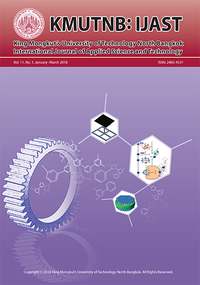Study of Temperature and Wear Variations of Aluminium in General Dry Sliding Contact
Main Article Content
Abstract
The present research focuses on the study of temperature and wear variations of aluminium in general dry sliding contact conditions. The main aim of this research is to develop a simulation methodology in order to calculate temperature and wear variations of different materials (here: aluminium on cast iron) in general dry sliding contacts. The developed simulation methodology is based on an uncoupled thermo-mechanical and wear analysis. The widely spread finite element software Abaqus is used for the numerical investigations. For calibration and validation, experimental investigations are performed with a pin-on-disc test bench. A comparison between the experimental and the numerical results is presented and discussed. The experimental results are in close agreement with the numerical results. For the considered test case (rotational velocity of the disc=300 rpm and load on the pin=110 N) the numerical analysis predicts a maximum temperature of 63°C in comparison to 65°C in the experiment. For the considered test case (rotational velocity of the disc=600 rpm and load on the pin=150 N) the simulation predicts a maximum temperature of 93°C in comparison to 97°C in the experiment. The study concludes that the developed simulation methodology is accurate and can be used to calculate temperature and wear variations of different materials in general dry sliding contact.
Article Details
References
[2] Standard terminology relating to wear and erosion, American Society for Testing and Materials, Standard G40, 2005.
[3] R. G. Bayer, Mechanical Wear Prediction and Prevention. New York: M. Dekker, 1994, pp. 280.
[4] S. K. Rhee, L. Halberstadt, and J. A. Mansfield, Wear of Materials. New York: ASME, 1977, pp. 560–568.
[5] F. T. Barwell, “Wear of machine elements,” in Fundamentals of Tribology, Cambridge, Massachusetts: The Mit Press, pp. 401–441, 1978.
[6] Wear control handbook, The American Society of Mechanical Engineers, New York, US, 1980.
[7] P. Podra and S. Andersson, “Simulating sliding wear with finite element method,” Tribology International, vol. 32, pp. 71–81, 1999.
[8] J. F. Molinari, M. Ortiz, R. Radovitzky, and E. A. Repetto, “Finite-element modeling of dry sliding wear in metals,” Engineering Computations, vol. 18, no. 3/4, pp. 592–609, 2001.
[9] V. Hegadekatte, S. Kurzenhauser, N. Huber, and O. Kraft, “A predictive modeling scheme for wear in tribometers,” Tribology International, vol. 41, pp. 1020–1031, 2008.
[10] H. Benabdallah and D. Olender, “Finite element simulation of the wear of polyoxymethylene in pin-on-disc configuration,” WEAR, vol. 261, pp. 1213–1224, 2006.
[11] S. C. Lim and M. F. Ashby, “Wear-Mechanism Maps,” Acta Metall, vol. 35, no. 1, pp. 1–24, 1987.
[12] S. M. Hsu, M. C. Shen, and A. W. Ru, “Wear prediction for metals,” Tribology International, vol. 30, pp. 377–383, 1997.
[13] H. Chen and A. T. Alpas, “Sliding wear map for the magnesium alloy Mg-9al-0.9 Zn (Az91),” WEAR, vol. 246, pp.106–116, 2000.
[14] S. Koetniyom, P. Brooks, and D. Barton, “The development of a material model for cast iron that can be used for brake system analysis,” SAGE Journal, vol. 216, no. 5, pp. 349–362, 2002.
[15] P. Dufrénoy and D. Weichert, “A thermomechanical model for the analysis of disc brake fracture mechanisms,” Journal of Thermal Stresses, vol. 26, no. 8, pp. 815–828, 2003.
[16] P. Dufrénoy, “Two-/three-dimensional hybrid model of the thermomechanical behaviour of disc brakes,” SAGE Journal, vol. 218, no. 1, pp. 17–30, 2004.
[17] S. Zhao, G. E. Hilmas, and L. R. Dharani, “Behavior of a composite multidisk clutch subjected to mechanical and frictionally excited thermal load,” WEAR, vol. 264, pp.1059–1068, 2008.
[18] T. Kao, J. Richmond, and A. Douarre, “Brake disc hot spotting and thermal judder: An experimental and finite element study,” International Journal of Vehicle Design, vol. 23, no. 3, pp. 276–296, 2000.
[19] A. Lamjahdy, J. F. Brunel, B. Lamure, P. Dufrenoy, D. Weichert, and B. Markert, “The cyclic thermomechanical coupled problem of thermal gradients in friction railway disc brakes,” PAMM, vol. 14, no. 1, pp. 461–462, 2014.
[20] A. Lamjahdy, J. Ali, and B. Markert, “Simulation of the temperature and wear behavior of disc brake,” PAMM, vol. 16, no. 1, pp. 217–218, 2016.
[21] A. Lamjahdy, N. Moussa, M. Hirtz, P. Dufrenoy, D. Weichert, H. Murrenhoff, and B. Markert, “Simulation of thermal gradients on hot bands of disc brakes,” presented at Euro Brake 2015, Dresden, Germany, May 4–6, 2015.
[22] B. Markert, “A survey of selected coupled multifield problems in computational mechanics,” Journal of Coupled Systems and Multiscale Dynamics, vol. 1, pp. 22–48, 2013.
[23] Standard Test Method for Wear Testing with a Pin-on-Disk Apparatus, American Society for Testing and Materials, Standard G99, 2005.
[24] A. Söderberg and S. Andersson “Simulation of wear and contact pressure distribution at the padto- rotor interface in a disc brake using general purpose finite element analysis software,” WEAR, vol. 267, pp. 2243–2251, 2009.


